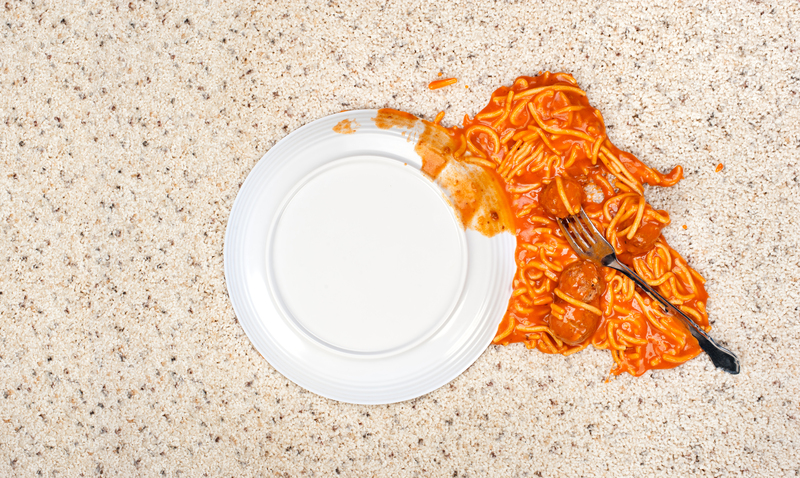Transform Mouldy Window Sills with Superior Cleaning Tips
Posted on 14/08/2025
Transform Mouldy Window Sills with Superior Cleaning Tips
Mouldy window sills are a common household challenge, particularly in damp and poorly ventilated environments. Tackling mould on window sills effectively is crucial, not just for aesthetic reasons, but to safeguard your home's air quality and prevent potential health hazards. In this comprehensive guide, we'll reveal proven cleaning tips, address prevention strategies, and explore long-term solutions to keep your window sills fresh, clean, and mould-free.
Why Do Window Sills Get Mouldy?
Understanding the causes behind mould growth on window sills is the first step in effectively combating the problem. Mould thrives in moist, warm, and poorly lit conditions -- all of which can occur around windows, especially during colder months when condensation is more likely.
- Condensation: Moisture accumulating on cold window panes drips onto sills creating a perfect habitat for mould.
- Poor Ventilation: Lack of airflow prevents dampness from evaporating, allowing fungal spores to settle and spread.
- Organic Material: Dust, dirt, or wood present on sills can provide nourishment for mould growth.
- Unattended Spills: Water from watering plants or accidental spills that are not cleaned up promptly.
*By addressing these underlying causes, you can prevent mould from reappearing on your window sills.*

Health Risks Associated With Mouldy Window Sills
Mould isn't just unsightly--it can pose several health risks. Regular exposure to mouldy window sills may lead to:
- Respiratory problems such as sneezing, coughing, and difficulty breathing
- Worsening of allergies or asthma symptoms
- Irritation of eyes, nose, and throat
- Potential infections in immunocompromised individuals
*Children, the elderly, and those with respiratory conditions are especially vulnerable. Regular maintenance and deep cleaning of window sills help protect your household's health.*
Essential Supplies for Cleaning Mouldy Window Sills
Effective cleaning starts with the right equipment. Gather these supplies to safely and thoroughly remove mould on window sills:
- Protective gloves and a face mask
- Safety goggles (to prevent mould spores from reaching eyes)
- Microfiber cloths or disposable towels
- Soft scrubbing brush
- Spray bottle
- White vinegar, baking soda, or a commercial mould remover
- Bucket of warm, soapy water
- Old toothbrush for tight corners
Optional Supplies for Heavily Moulded Window Sills
- Hydrogen peroxide (3% solution)
- Bleach-based cleaner (only for non-porous surfaces like uPVC or tile)
- Moisture absorber packets for after-cleaning
Step-By-Step Guide: How to Clean Mould from Window Sills
Transforming mouldy window sills into sparkling clean surfaces is easier than you think, provided you follow these effective methods:
1. Prepare the Area
- Open windows to improve ventilation and reduce inhalation of mould spores.
- Remove any objects, such as plants or picture frames, from the window sill.
2. Protect Yourself
- Wear gloves, masks, and goggles to prevent direct contact with mould or inhaling spores.
3. Dry Brush the Surface
- Use a dry brush to gently remove loose mould and dust. Wipe with a damp, disposable towel. Dispose of these materials immediately.
4. Apply a Cleaning Solution
- White Vinegar: Pour undiluted vinegar into a spray bottle. Spray generously on the affected area. Let it sit for 1 hour.
- Baking Soda: Mix one teaspoon of baking soda with two cups of water in a spray bottle. Shake well, spray the surface, and leave for 15-20 minutes.
- Commercial Mould Remover: Follow manufacturer's instructions for application and safety.
5. Scrub the Area
- Using a soft brush or old toothbrush, scrub the sill to remove mould stains.
- Avoid using abrasive materials that could damage paint or frames.
6. Rinse and Dry Thoroughly
- Wipe the area with a clean, damp cloth.
- Dry thoroughly using a fresh towel to prevent any moisture from lingering.
7. Repeat if Necessary
- For persistent mould, repeat the process or try hydrogen peroxide for an extra-strength clean (always test in a hidden spot first).
8. Dispose of Cleaning Materials Safely
- Seal used gloves, cloths, and disposable towels in a plastic bag and discard to prevent the spread of spores.
Deep Cleaning Heavily Moulded Window Sills
If your window sills have been neglected or the mould infestation is severe, a more intensive approach may be required. Here's how to tackle stubborn, ingrained mould:
- Remove loose paint or wood chips to ensure cleaning solutions penetrate effectively.
- Apply bleach-based cleaner (for non-porous surfaces only). Mix 1 part bleach to 4 parts water, apply with a spray bottle, and allow to sit for 10-15 minutes.
- Scrub vigorously using a stiff brush or scouring pad.
- Neutralize and rinse: Wipe with clean water to remove all residues.
- Sand and repaint damaged wood to seal surfaces and prevent future mould growth.
Always exercise caution and ensure the area is well ventilated when using stronger chemicals.
Natural Remedies vs. Commercial Cleaners for Mouldy Window Sills
Wondering whether to use natural or commercial products? Both have advantages:
- Natural Cleaners (vinegar, baking soda, tea tree oil) are eco-friendly, cost-effective, and safe for most surfaces, but may require repeated applications.
- Commercial Cleaners offer fast, potent results, especially for tough or persistent mould, but should be used with care--especially around children and pets.
*Choose the approach that best fits your environment, the type of window sill, and your personal preference.*
How to Prevent Mould on Window Sills: Long-Term Solutions
The ultimate victory over mould on window sills lies in prevention. Here are expert tips to keep your sills spotless and healthy all year round:
- Improve Ventilation: Open windows regularly and use extractor fans, especially in kitchens and bathrooms.
- Reduce Humidity: Install a dehumidifier, use moisture-absorbing products, or regularly ventilate the room.
- Wipe Down Condensation: Every morning, quickly wipe away any moisture collecting on windows and sills.
- Avoid Overwatering Plants: Use saucers under pots and mop up any water spills quickly.
- Seal Cracks and Repair Leaks: Prevent water intrusion and persistent dampness by keeping window frames in good repair.
- Use Anti-Mould Paint: For wooden or painted sills, consider applying a protective anti-mould coating after cleaning.
- Regular Cleaning Schedule: Incorporate window sill maintenance into your standard weekly cleaning routine.
Special Considerations for Different Window Sill Materials
Wooden Window Sills
- Never saturate with water as it may cause warping.
- Use diluted vinegar and a soft cloth.
- If mould persists, lightly sand the affected area before repainting.
uPVC or Vinyl Window Sills
- More resistant to moisture and easier to clean.
- Commercial cleaners or diluted bleach are effective; ensure thorough rinsing.
Stone, Tile, or Metal Sills
- Use non-acidic cleaners to avoid surface etching.
- Vinegar may damage some stone types--test on a hidden spot.
*Always verify the cleaning method on a small, hidden section first to avoid accidental surface damage.*
Frequently Asked Questions: Cleaning Mouldy Window Sills
Q: How often should I check window sills for mould?
A: Inspect your window sills at least once a month, especially during winter or rainy weather. Early detection makes cleaning far easier.
Q: Is it safe to use bleach on all window sill types?
A: Bleach can damage wood and some painted surfaces. Use it only on non-porous sills like uPVC or tile, and always follow manufacturer instructions.
Q: Can I prevent future mould growth permanently?
A: While it's difficult to guarantee 100%, combining superior cleaning tips, improved ventilation, and regular maintenance will dramatically reduce mould recurrence on window sills.
Q: Should I replace heavily damaged or rotten window sills?
A: If mould has deeply penetrated and weakened the material, replacement may be necessary for lasting results and health reasons.

Summary: Your New, Mould-Free Window Sills
With the right techniques and a little diligence, mouldy window sills can be completely transformed into clean, safe, and attractive features of your home. Here's a quick recap of our superior cleaning tips:
- Act quickly at the first sign of mould for easier removal.
- Use protective gear and safe cleaning products for your sill's material.
- Focus on ventilation, moisture control, and regular cleaning to prevent mould recurrence.
- Customize your approach based on whether sills are wood, uPVC, or stone.
Transforming mouldy window sills takes a mix of effective cleaning, preventive measures, and ongoing attention. Consistently applying these expert strategies will give you a healthier, fresher home--beautiful window sills included!
Further Resources
For regular advice on home cleaning and maintenance, bookmark our blog and share these superior mould removal tips for window sills with your family and friends.




